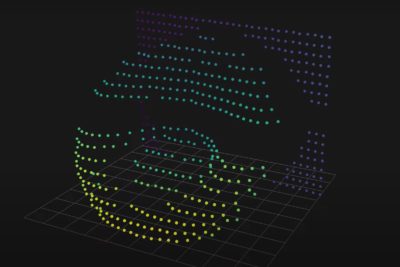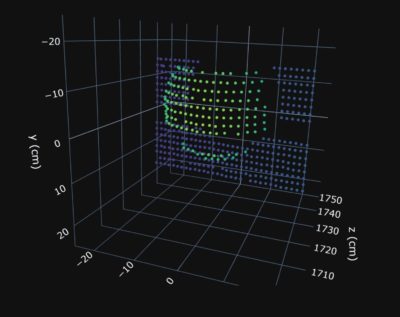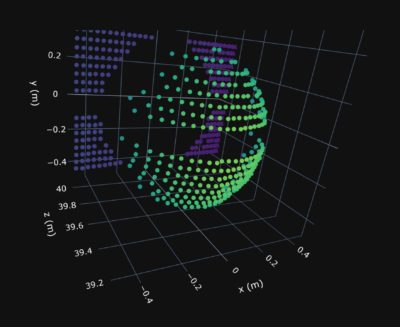
Swivel chair and screen at 40 M – picture taken using a 32×16 pixel sensor (2mmx2.5mm sensor size). Image courtesy Pointcloud Inc.
Researchers in San Francisco and Southampton have developed the first compact 3D LiDAR imaging system that can match and exceed the performance and accuracy of most advanced, mechanical systems currently used.
3D LiDAR can provide accurate imaging and mapping for many applications; it is the “eyes” for autonomous cars and is used in facial recognition software and by autonomous robots and drones. Accurate imaging is essential for machines to map and interact with the physical world but the size and costs of the technology currently needed has limited LIDAR’s use in commercial applications.

Basketball and screen at 17 m – picture taken using a 32×16 pixel sensor (2mmx2.5mm sensor size). Image courtesy Pointcloud Inc.
Now a team of researchers from Pointcloud Inc in San Francisco and the University of Southampton’s Optoelectronic Research Centre (ORC) have developed a new, integrated system, which uses silicon photonic components and CMOS electronic circuits in the same microchip. The prototype they have developed would be a low-cost solution and could pave the way to large volume production of low-cost, compact and high-performance 3D imaging cameras for use in robotics, autonomous navigation systems, mapping of building sites to increase safety and in healthcare.

Exercise ball and screen at 40 m – picture taken using a 32×16 pixel sensor (2mmx2.5mm sensor size). Image courtesy Pointcloud Inc.
Remus Nicolaescu, the CEO of Pointcloud Inc said, “The combination of high performance and low cost manufacturing will accelerate existing applications in autonomy and augmented reality. But even more importantly, it will open new fields, such as industrial and consumer digital twin applications requiring high depth accuracy, or remote behavioural and vital signs monitoring for preventive healthcare, requiring accurate motion mapping.”
Graham Reed, Professor of Silicon Photonics within the ORC added, “LIDAR has been promising a lot but has not always delivered on its potential in recent years because, although experts have recognised that integrated versions can scale down costs, the necessary performance has not been there. Until now.
“The silicon photonics system we have developed provides much higher accuracy at distance compared to other chip-based LIDAR systems to date, and most mechanical versions, showing that the much sought-after integrated system for LIDAR is viable.”
The latest tests of the prototype, published in the journal Nature, show that it has an accuracy of 3.1 millimetres at a distance of 75 metres.
Amongst the problems faced by previous integrated systems are the difficulties in providing a dense array of pixels that can be easily addressed; this has restricted them to fewer than 20 pixels whereas this new system is the first large-scale 2D coherent detector array consisting of 512 pixels. The research teams are now working to extend the pixels arrays and the beam steering technology to make the system even better suited to real-world applications and further improve performance.
The paper “A universal 3D imaging sensor on a silicon photonics platform” has been published in Nature with DOI 10.1038/s41586-021-03259-y and is available at: https://www.nature.com/articles/s41586-021-03259-y
For further information, please contact Remus Nicolaescu, remus.nicolaescu@point.cloud. https://point.cloud/
